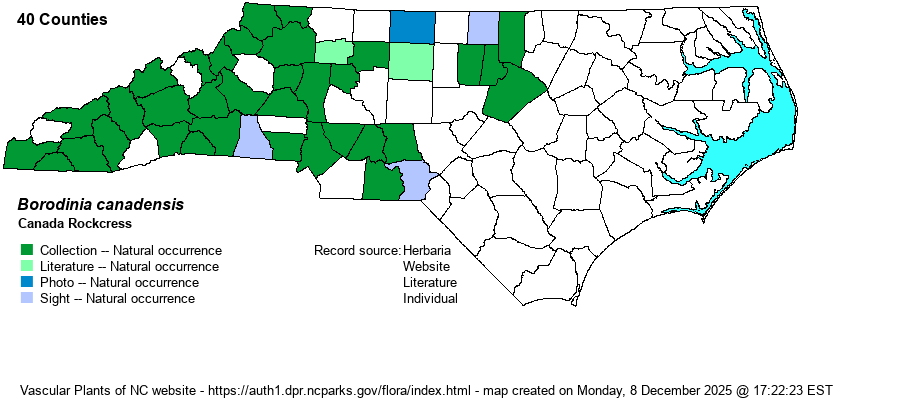| Author | (Linnaeus) P.J. Alexander & Windham | |
| Distribution | Throughout the Mountains; in the Piedmont, found mostly in the upper and southern portions, and widely scattered east to Granville and Wake counties.
This is a widespread Eastern species, from New England and ND south to the FL Panhandle and central TX; it is generally absent on the Coastal Plains.
| |
| Abundance | Fairly common to frequent in the Mountains; infrequent to fairly common in the southwestern part of the Piedmont, but rare to locally uncommon farther eastward. Seemingly very rare in much of the central Piedmont. | |
| Habitat | This is a species of rocky forests, and outcrops, usually restricted to circumneutral to only barely acidic soil. It may be found in quite dry places as well as rather rich ones, but normally is found in somewhat open woods and edges, rather than in deep shade. It grows on open rocky slopes, around rock outcrops, on roadcuts or rocky edges, and other similar places. |
| Phenology | Blooms from May to July, and fruits from June to August. | |
| Identification | This is a moderate to tall herb, growing to about 2-3 feet tall. The stem is hairy toward the base but mostly smooth, and is typically unbranched or is branched in the upper portion. There are basal leaves, but they disappear by the time of flowering. The stem leaves are variable up the stem, and are alternate. In general, they are lanceolate to narrowly elliptic, somewhat pubescent, about 3 inches long but barely 3/4-inch wide, usually sessile or tapering to the base, and normally with some serrations. The flower cluster is a raceme at the top of the stem, with scattered white flowers; each has 4 narrow petals and a spread of 1/3-inch across -- not at all showy. The main identification feature is the decurved pedicels; after the flowers are spent, the long and narrow siliques (about 3 inches long) hang downward owing to the curve in the pedicels. In other species, especially the quite similar B. laevigata, the pedicels are spreading, and the siliques are arranged more horizontally, though with a gentle downward curve to the silique. Other separating characters between these two widespread NC species are that B. laevigata has smooth and glaucous leaves (pale green), and they have a strongly clasping leaf base. B. canadensis leaves are medium green and taper to the stem; nonetheless, identification of some plants can be tricky, not that they hybridize. Both grow in the same places -- rocky slopes and usually on high pH soils -- and both are not uncommon in places, and thus care should be taken to separate these species. | |
| Taxonomic Comments | This species was placed in the genus Arabis for most of the last century. It was generally moved to Boechera for a while in the 21st Century, but Weakley (2020) moved the Boechera species to Borodinia.
| |
| Other Common Name(s) | Sicklepod. This common name is usually reserved for Senna obtusifolia, a legume. All the Borodinia species go by the group common name of "rockcress". | |
| State Rank | S4 | |
| Global Rank | G5 | |
| State Status | | |
| US Status | | |
| USACE-agcp | | |
| USACE-emp | | |

